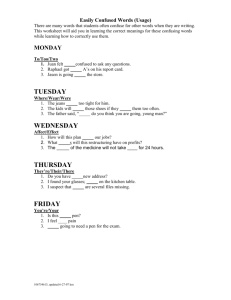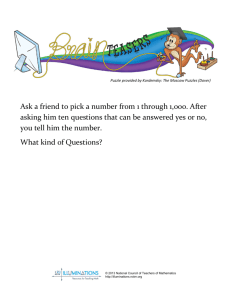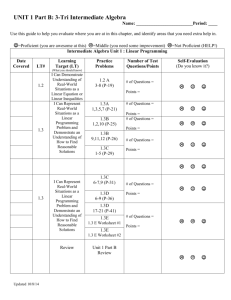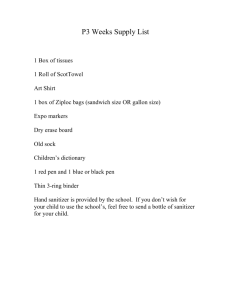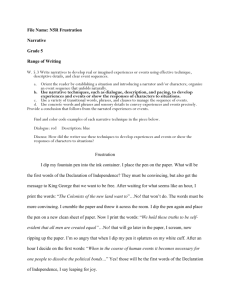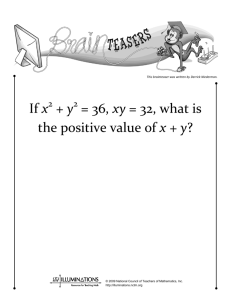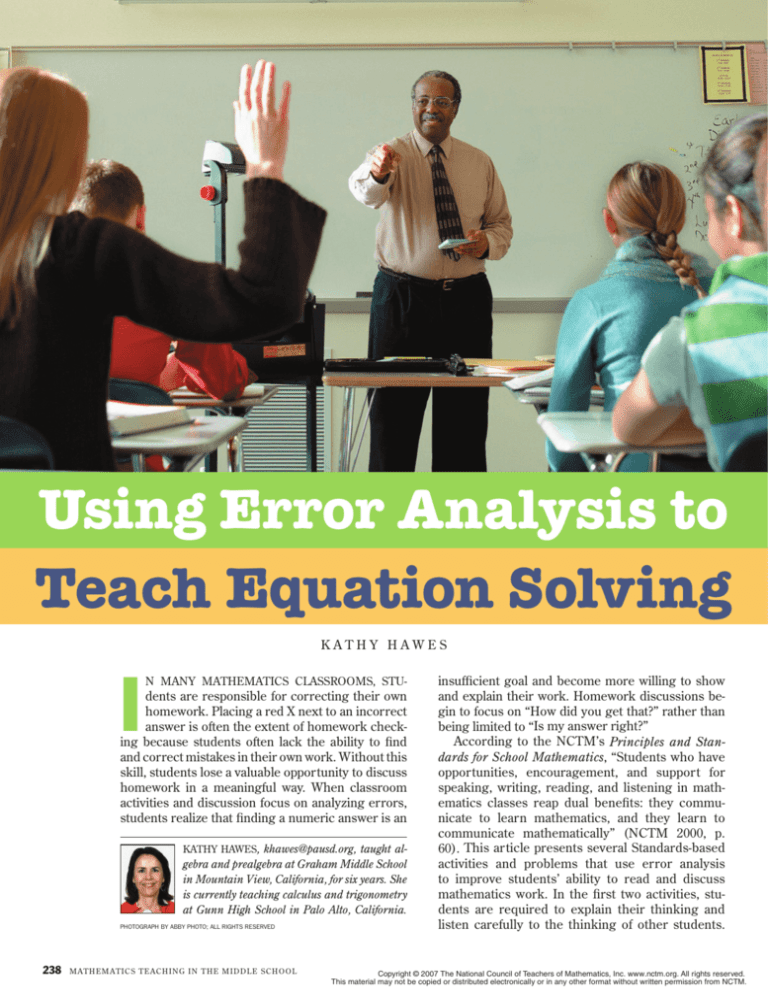
Using Error Analysis to
Teach Equation Solving
Kathy Hawes
I
n many mathematics classrooms, stu-
dents are responsible for correcting their own
homework. Placing a red X next to an incorrect
answer is often the extent of homework checking because students often lack the ability to find
and correct mistakes in their own work. Without this
skill, students lose a valuable opportunity to discuss
homework in a meaningful way. When classroom
activities and discussion focus on analyzing errors,
students realize that finding a numeric answer is an
Kathy Hawes, khawes@pausd.org, taught al-
gebra and prealgebra at Graham Middle School
in Mountain View, California, for six years. She
is currently teaching calculus and trigonometry
at Gunn High School in Palo Alto, California.
Photograph by Abby Photo; all rights reserved
238
MATHEMATICS TEACHIN G IN THE MI DDLE SCHOOL
insufficient goal and become more willing to show
and explain their work. Homework discussions begin to focus on “How did you get that?” rather than
being limited to “Is my answer right?”
According to the NCTM’s Principles and Standards for School Mathematics, “Students who have
opportunities, encouragement, and support for
speaking, writing, reading, and listening in mathematics classes reap dual benefits: they communicate to learn mathematics, and they learn to
communicate mathematically” (NCTM 2000, p.
60). This article presents several Standards-based
activities and problems that use error analysis
to improve students’ ability to read and discuss
mathematics work. In the first two activities, students are required to explain their thinking and
listen carefully to the thinking of other students.
Copyright © 2007 The National Council of Teachers of Mathematics, Inc. www.nctm.org. All rights reserved.
This material may not be copied or distributed electronically or in any other format without written permission from NCTM.
Written on the Board
Student Explanation
2(x + 1) = x – 4(x – 2)
Teacher presents problem.
2x + 2 = x – 4(x – 2)
Student 1 uses the distributive property.
2x + 2 = x – 4x – 8
Student 2 uses the distributive property incorrectly. This step is
later circled and identified as a common error.
2x + 2 = x + –4(x + –2)
Amanda writes her idea on the board.
2x + 2 = x + –4x + 8
Student 2 corrects the error after discussion.
2x + 2 = –3x + 8
Student 3 combines like terms.
3x + 2x + 2 = 3x + –3x + 8
5x + 2 = 8
Student 4 adds 3x to both sides to get all the variable terms on one side.
5x + 2 – 2 = 8 – 2
5x = 6
x = 6/5
Student 5 writes an alternate solution from his homework paper,
explaining that he subtracted 2.
2x + 2 – 2 = –3x + 8 – 2
2x = –3x + 6
Then he subtracts 2 from student 4’s solution.
Student 6 divides both sides by 5 because division “undoes”
multiplication.
Fig. 1 A typical problem solved during “pass the pen”
Through the third activity, in-class journal writing
and take-home writing projects, students develop
an understanding of common errors and improve
their ability to communicate effectively with others when correcting homework. Although all the
examples come from a unit on linear equation solving, the ideas and activities presented in this article
have been used successfully in other algebra units
and in other courses.
Activity 1: Pass the Pen
According to the NCTM’s Standards, “For
some students, participation in class discussions is a
challenge” (NCTM 2000, p. 61). The “pass the pen”
activity is structured so that class discussion involves every student. The teacher writes a multistep
mathematics problem on the whiteboard and calls
on one student to come up and complete the first
step. The teacher gives the student a whiteboard
marker, or pen, to write his or her work. The student
explains not only how to complete the step but also
the reasoning behind it. The student holding the
pen then calls on a second student to complete the
next step, and “passes the pen.” After completing a
step, each student passes the pen to another until
the problem is finished. When a question arises, the
person holding the pen must answer the question,
call on another student for help, or pass the pen to a
different student. Typically during this activity, one
or more errors will be made by students, as in the
following scenario referring to figure 1.
Student 2: I used the distributive property, like in
the first step. [Hands go up all over the room. Student
2 is alerted by this action that she has made a mistake
and looks to the teacher.] Isn’t that right?
Teacher: If you have a question, why don’t you call
on someone to help you? [Student 2 looks around the
room and chooses Mario.]
Mario: You forgot about the subtraction sign in
front of the 4.
Student 2: [Obviously still confused.] I don’t get
it. That’s why it’s subtracting 4x. I multiplied the 4
and the 2 to get 8. [She calls on Amanda for more
assistance.]
Amanda: If you write subtraction as adding the opposite, the problem is –4 times –2 and that’s +8. You
got –8 because you didn’t look at both negatives.
Teacher: Amanda, will you write your idea on the
board so that everyone can better understand what
you are saying? [Student 2 hands Amanda the pen,
and she writes her idea on the board. When Amanda
is finished, she returns the pen to student 2.]
Student 2: Oh, I get it. A negative times a negative
is a positive. You have to write the subtraction as an
addition problem to see both negatives. [She corrects
her work and passes the pen to a new student.]
Solving a problem in this manner will clearly take
more time than a teacher-presented solution given
during a lecture. The extra time is necessary, because
students require time to think between each step and
formulate their questions. During a lecture, many
middle-level students have difficulty simultaneously
V OL. 1 2 , NO. 5 . D e c e m b e r 2 0 0 6 / J a n u a r y 2 0 0 7
239
judge whether the differing solutions are both correct. If both solutions are correct, students can form
their own opinion about which solution is easier. If
a solution is incorrect, it is helpful to add notes to
clarify the error so that students can avoid a similar
mistake in future work.
A key element of “pass the pen” is that everyone
must participate. No one can go to the board a second time until everyone has held the pen at least
once. Students who usually do not present solutions at the board know that they will have to take
a turn and look for an opportunity to participate.
This activity is also effective because the person
who holds the pen is always in charge of the discussion, not the teacher. Thus, although everyone
must take a turn, he or she can always call on another student for help or pass the pen if feeling uncomfortable. The role of the teacher during “pass
the pen” is to enforce the participation rules and
ask questions that will take the discussion deeper:
Why did you do that? Is that the only possible next
step? Will that always work? How is that different
from the last problem?
Activity 2: Find an Expert
copying notes and processing the ideas. As an additional benefit, the teacher has an informal opportunity
to assess what concepts are still giving students difficulty, as in the dialogue below when student 5 is uncertain how to proceed.
Student 5: That’s not what I got [referring to student 4’s work]. I don’t know what to do next!
Teacher: Why don’t you write what you did on the
board and call on someone to help you? [Student 5
copies work from his homework paper.]
Student 5: [Looking for hands.] I got 2x = –3x + 6;
does that mean I’m wrong? [Student 5 calls on Tran.]
Tran: I did what you did, and I think it’s right because I just subtracted 2 from both sides then added
3x. Student 3 has already added the 3x, so you can
subtract 2 from both sides now, and it will still work.
[Student 5 subtracts 2 from both sides.]
Teacher: [To student 5.] Does that agree with the
answer you got on your homework?
Student 5: Yes. [Student pauses and thinks.] Can
you always do the steps in any order?
The discussion continues by students passing the
pen to other students. When disagreements or different solutions occur during the discussion, it is
helpful to write alternative solutions on the board in
addition to the original solution. Students will benefit from the opportunity to compare solutions and
240
MATHEMATICS TEACHIN G IN THE MI DDLE SCHOOL
In this activity, students take turns being
the expert and the questioner. It is a useful way
for students to correct their own work on a quiz or
homework assignment. Students love the opportunity to move around the room and work with different people. They also appreciate playing different
roles in the activity. The teacher can assign roles for
particular problems or allow students to select their
own partners.
Students are instructed to write in a binder the
correct solutions to the problems they missed by
consulting a different expert for each missed problem. An expert, someone who solved the problem
correctly, is instructed not to show his or her own
paper to anyone but to find mistakes and answer
questions. The questioner, the student who missed
the problem, is to ask enough questions to be able
to write the correct solution on the binder paper.
“It is difficult for students to learn to consider,
evaluate, and build on the thinking of others, especially when their peers are still developing their own
mathematical understandings” (NCTM 2000, p. 63).
The rules of this activity discourage copying and encourage discussion of students’ thinking. Because
the expert cannot write on the binder paper, he or
she must use words to explain his or her thinking. It
is useful to model good questions before the activity
begins. For example, “Why did you divide by 3?” is a
more thoughtful question than “What should I write
next?” During the activity, the teacher monitors the
Common Error
Reason for Confusion (False Analogy)
2x + 3x = 5x
Students confuse 2x + 3x = 5x, where only the coefficients are added, with
2x • 3x = 6x2, where the coefficients as well as the variable are multiplied.
–32 = 9
Students remember that the square of a negative is positive but forget the
importance of parentheses.
(–3)2 = +9 and –32 = –9
6x – (x – 3) = 6x – x – 3
Students fail to understand that subtracting quantities is different from adding
quantities. Another problem can look similar to students.
6x + (3x – 3) = 6x + 3x – 3
–|–2| = 2
Students find it difficult to distinguish between absolute value and parentheses.
–(–2) = +2 but –|–2| = –2
2
Fig. 2 Various ideas for writing prompts
discussions in the classroom. A conversation where
an expert explains a solution incorrectly provides an
excellent opportunity for the teacher to ask clarifying questions of his or her own. Sometimes a pair of
students become stumped and are unable to figure
out the mistake in the questioner’s method. This
situation also provides an excellent problem for further class discussion or journal writing.
Explain how to fix this simplification. Give reasons.
(2x + 1) – (x + 6) = 2x + 1 – x + 6
Activity 3: Journal Writing
Students are prepared to describe their
thinking in journals after discussing problem solutions
and working collaboratively to find errors. It is helpful
to have students write in journals on a regular basis
and organize journal entries around common errors
(see fig. 2). A careful reading of student responses
can give insight into the current depth of understanding for each student. When asked to find the mistake
in the following journal entry, three students demonstrate different levels of understanding (see fig. 3).
Gabrielle attempts to prove the simplification is
incorrect by evaluating the expression. Although
she is clearly aware that the order of operations is required, her work is unclear and she is unable to find
the mistake or the correct simplification. Prabdheep
is also unable to correctly simplify the expression,
although his explanation of the distributive property
is clear. He correctly explains that the +6 should be
–6, but he believes the student should also replace
1 – x with –1x. Prabhdeep forgets to add the constant term of 1 in the first quantity of (2x + 1) and introduces a new error. Only Briannon simplifies the
expression correctly by equating the subtracting of
quantities and the distributing of a negative.
Activity 4: Exams and Take-Home Projects
“To ensure deep, high-quality learning for
all students, assessment and instruction must be
integrated” (NCTM 2000, p. 23). It is essential that
Gabrielle’s solution
Prabdheep’s solution
Briannon’s solution
Fig. 3 A sample journal problem, listed at top, is explained three ways by three
students.
V OL. 1 2 , NO. 5 . D e c e m b e r 2 0 0 6 / J a n u a r y 2 0 0 7
241
students have the opportunity to demonstrate their
ability for error analysis on tests and projects. This
format provides an effective measure of understanding, because students must explain their thinking.
Test questions should be short and focus on a
single concept. The sample questions in figure 4
give students the opportunity to demonstrate their
understanding of the distributive property in the
first question and the addition property of quality
on the second problem (see fig. 4). Note that there
are student errors in problem 12; the simple error
is easily found using this format. A third problem
assesses students’ ability to set up word problems
(see fig. 5).
Including error analysis as part of a take-home
test or project presents students with the opportunity to demonstrate their knowledge on more complicated multistep problems. A typical take-home assessment requires students to identify two or three
errors in a single solution, write a correct solution,
and justify their reasoning for each step. At home,
students do not work under the same time pressure
as in-class tests and have the opportunity to express
their mathematical thinking more thoughtfully.
Fig. 4 Sample exam questions
Conclusion
Allowing opportunities to discuss and ex-
plain common errors can help students become more
accurate at solving linear equations and working
cooperatively to correct their homework. Students
are most effective when they have the opportunity
to explain their thinking daily in classroom discussions as well as in smaller collaborative groups.
Activities like “pass the pen” and “find an expert”
should be used once or twice during a unit to foster
active student discussion and participation. As students become better at error analysis, they should
be given the opportunity to work alone and explain
their ideas in journal writings several times a week
and on graded tests and take-home projects at the
end of the unit. Questions requiring error analysis
are effective tools to assess students’ understanding
of linear equation solving because error analysis requires a deeper understanding of equation solving
than simply “doing the problem.”
Bibliography
Fig. 5 Another example of an exam question
242
MATHEMATICS TEACHIN G IN THE MI DDLE SCHOOL
Larson, Ron, Laurie Boswell, Timothy D. Kanold, and Lee
Stiff, Algebra 1 Chapter 3 Resource Book. Evanston, IL:
McDougal Littell, 2001.
National Council of Teachers of Mathematics (NCTM).
Principles and Standards for School Mathematics. Reston, VA: NCTM, 2000. l

